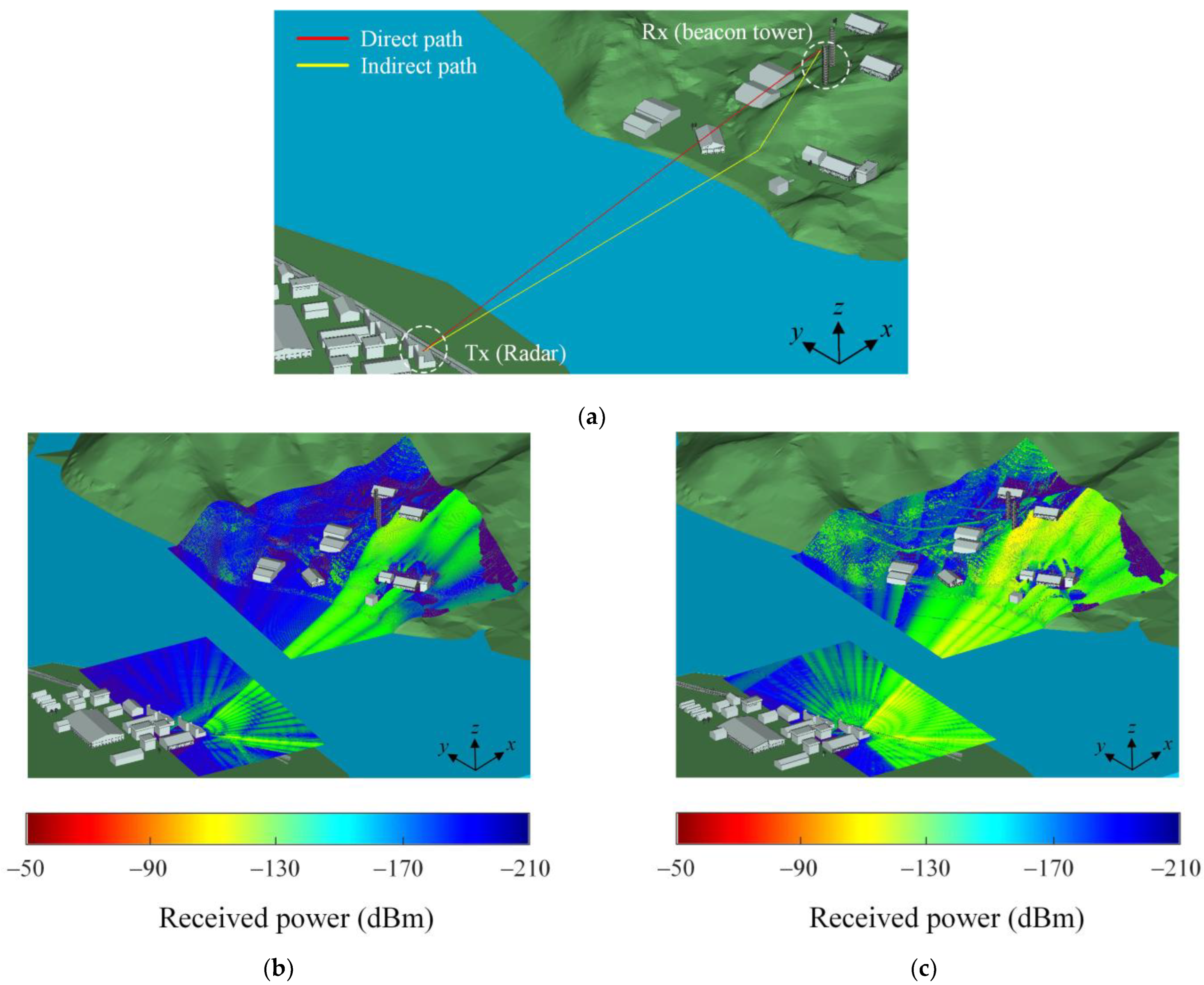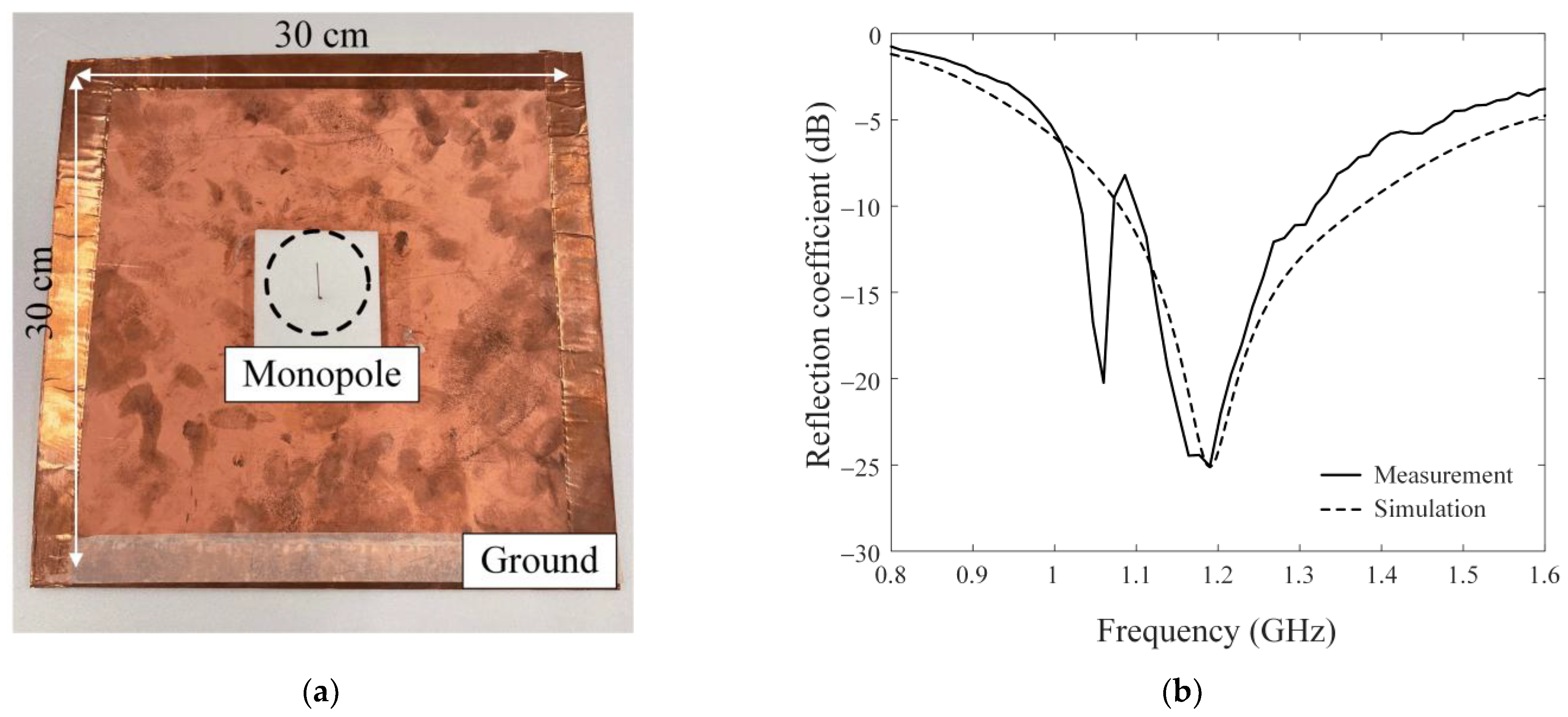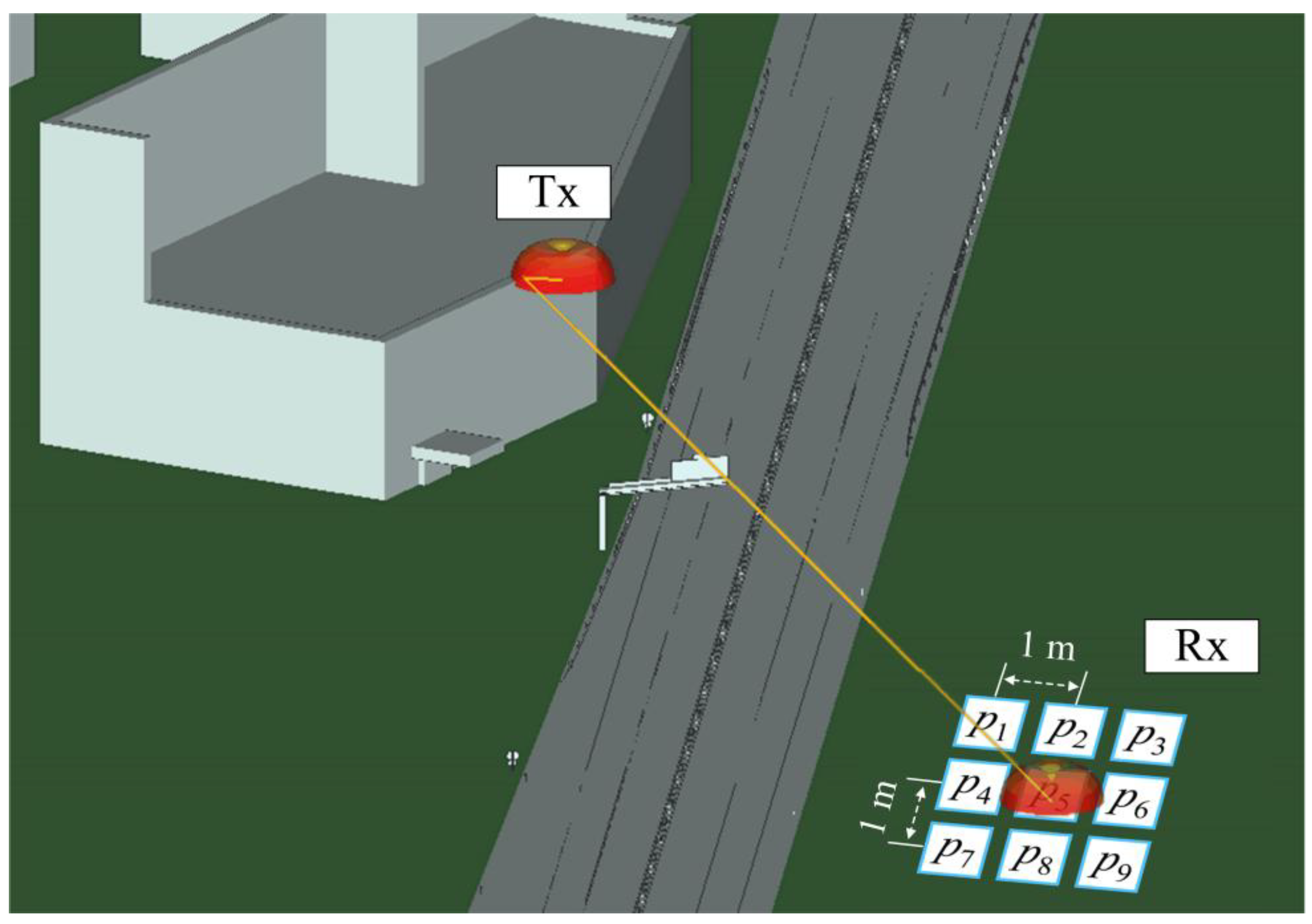Analysis of High-Power Radar Propagation Environments Around the Test Site
Abstract
1. Introduction
2. Method for Analyzing Propagation Environments and Modeling Radar Sites
3. Analysis of the Propagation Environment During Radar Operation
4. Verification of Analysis Results Through Comparison of Measurement and Simulation
5. Conclusions
Author Contributions
Funding
Institutional Review Board Statement
Informed Consent Statement
Data Availability Statement
Conflicts of Interest
References
- Bang, S.; Kim, H.; Oh, J. Enhancing 2-D Beam Scanning Capability through Extended Transmission Paths in a Liquid Crystal-Based Transmitarray Antenna for mmWave Communications. J. Electromagn. Eng. Sci. 2025, 25, 85–91. [Google Scholar] [CrossRef]
- Yoon, J.H.; Park, Y.; Roh, J.E. Rejection of Surface Clutter in Far Sidelobes for Airborne Radars. J. Electromagn. Eng. Sci. 2024, 24, 467–476. [Google Scholar] [CrossRef]
- Yousaf, J.; Yakoub, S.; Karkanawi, S.; Hassan, T.; Almajali, E.; Zia, H.; Ghazal, M. Through-the-Wall Human Activity Recognition Using Radar Technologies: A Review. IEEE Open J. Antennas Propag. 2024, 5, 1815–1836. [Google Scholar] [CrossRef]
- Park, J.H.; Park, S.C. Complex Range Resolution Model of Point Scatterers in LFM Chirp Pulse Radar. IEEE Trans. Instrum. Meas. 2022, 71, 4506112. [Google Scholar] [CrossRef]
- Kim, B.; Jin, Y.; Bae, J.; Hyun, E. Two-Step Adaptive Target Detection Scheme Using Beam-Steering FMCW Radar Sensors. J. Electromagn. Eng. Sci. 2024, 24, 674–676. [Google Scholar] [CrossRef]
- Zhong, J.; Zhang, K.; Zeng, Q.; Liu, X. A False Alarm Elimination Algorithm of Foreign Objects Debris Detection Based on Duffing Oscillator. IEEE Access 2022, 10, 7588–7598. [Google Scholar] [CrossRef]
- Chen, X.; Su, N.; Huang, Y.; Guan, J. False-Alarm-Controllable Radar Detection for Marine Target Based on Multi Features Fusion via CNNs. IEEE Sens. J. 2021, 21, 9099–9110. [Google Scholar] [CrossRef]
- Zhu, Y.; Li, Y.; Zhang, Q. False-Alarm-Controllable Radar Target Detection by Differentiable Neyman Pearson Criterion for Neural Network. IEEE Trans. Geosci. Remote Sens. 2023, 61, 5108014. [Google Scholar] [CrossRef]
- Braun, N.; Ziemer, F.; Bezuglov, A.; Cysewski, M.; Schymura, G. Sea-Surface Current Features Observed by Doppler Radar. IEEE Trans. Geosci. Remote Sens. 2008, 46, 1125–1133. [Google Scholar] [CrossRef]
- Conte, E.; De Maio, A.; Farina, A. Statistical Tests for Higher Order Analysis of Radar Clutter: Their Application to L-Band Measured Data. IEEE Trans. Aerosp. Electron. Syst. 2005, 41, 205–218. [Google Scholar] [CrossRef]
- Ng, K.H.; Tameh, E.K.; Nix, A.R.A. New Heuristic Geometrical Approach for Finding Non-Coplanar Multiple Edge Diffraction Ray Paths. IEEE Trans. Antennas Propag. 2006, 54, 2669–2672. [Google Scholar] [CrossRef]
- Silva, J.C.; Costa, E. A Ray-Tracing Model for Millimeter-Wave Radio Propagation in Dense-Scatter Outdoor Environments. IEEE Trans. Antennas Propag. 2021, 69, 8618–8624. [Google Scholar] [CrossRef]
- Puggelli, F.; Carluccio, G.; Albani, M.A. Novel Ray Tracing Algorithm for Scenarios Comprising Pre-Ordered Multiple Planar Reflectors, Straight Wedges, and Vertexes. IEEE Trans. Antennas Propag. 2014, 62, 4336–4339. [Google Scholar] [CrossRef]
- Ministry of Science and ICT. Criteria for Protecting the Human Body from Electromagnetic Waves; No. 2017-7; Ministry of Science and ICT: Sejong, Republic of Korea, 2017. [Google Scholar]
- Deme, A.; Dajab, D.; Bajoga, B.; Mu’azu, M.; Choji, D. Hata-Okumura Model Computer Analysis for Path Loss Determination at 900 MHz for Maiduguri, Nigeria. Math. Theory Model. 2013, 3, 1–9. [Google Scholar]
- International Telecommunication Union. Prediction Procedure for the Evaluation of Interference between Stations on the Surface of the Earth at Frequencies Above About 0.1 GHz; Recommendation ITU-R P.452-17; ITU: Geneva, Switzerland, 2021. [Google Scholar]
- International Telecommunication Union. Propagation Data and Prediction Methods Required for the Design of Terrestrial Line-of-Sight Systems; Recommendation ITU-R P.530-18; ITU: Geneva, Switzerland, 2021. [Google Scholar]
- International Telecommunication Union. Method for Point-to-Area Predictions for Terrestrial Services in the Frequency Range 30 MHz to 4,000 MHz; Recommendation ITU-R P.1546-6; ITU: Geneva, Switzerland, 2019. [Google Scholar]
- Jang, D.; Wang, S.; Kim, C.W.; Park, Y.B.; Choo, H. Method for Estimating Optimal Position of S-Band Relay Station through Path Loss Analysis in an Outdoor Environment. Appl. Sci. 2020, 10, 6089. [Google Scholar] [CrossRef]
- Jang, D.; Youn, S.; Park, J.-E.; Choo, J.; Choo, H. Electromagnetic Field Propagation and Indoor Exclusion Zone Analysis in a Nuclear Power Plant. IEEE Trans. Electromagn. Compat. 2020, 62, 2386–2393. [Google Scholar] [CrossRef]
- Albani, M.; Carluccio, G.; Pathak, P.H. A Uniform Geometrical Theory of Diffraction for Vertices Formed by Truncated Curved Wedges. IEEE Trans. Antennas Propag. 2015, 63, 3136–3144. [Google Scholar] [CrossRef]
- Song, C.M.; Trinh-Van, S.; Yi, S.-H.; Bae, J.; Yang, Y.; Lee, K.-Y.; Hwang, K.C. Analysis of Received Power in RF Wireless Power Transfer System With Array Antennas. IEEE Access 2021, 9, 76315–76326. [Google Scholar] [CrossRef]
- Remcom: Wireless InSite. 2019. Available online: http://www.remcom.com/wireless-insite (accessed on 24 March 2025).
- The Ministry of Land, Infrastructure, and Transport: Digital Elevation Angle. 2019. Available online: https://www.data.go.kr/ (accessed on 24 March 2025).
- Jang, D.; Kim, J.; Park, Y.B.; Choo, H. Study of an Atmospheric Refractivity Estimation from a Clutter Using Genetic Algorithm. Appl. Sci. 2022, 12, 8566. [Google Scholar] [CrossRef]
- CST Studio Suite: Electromagnetic Field Simulation Software. Available online: http://www.cst.com (accessed on 24 March 2025).










| Parameters | X-Band (8 GHz) | Ku-Band (18 GHz) |
|---|---|---|
| Realized gain (dBi) | 30.07 | 35.86 |
| 3 dB beam width (°) | 4.9 | 2.2 |
| Side lobe level (dB) | 13.3 | 13.5 |
| X-Band | Ku-Band | ||
|---|---|---|---|
| Minimum received power (dBm) | Tx. area | −216.75 | −218.17 |
| Rx. area | −218.87 | −219.95 | |
| Maximum received power (dBm) | Tx. area | −44.39 | −59.09 |
| Rx. area | −52.86 | −59.94 | |
| Height of Absorber | Frequency | W/O Absorber | With Absorber | Attenuation Rate |
|---|---|---|---|---|
| 1 m | 8 GHz | 1.52 V/m | 0.92 V/m | 39.47% |
| 18 GHz | 2.77 V/m | 1.68 V/m | 39.35% | |
| 1.5 m | 8 GHz | 1.52 V/m | 0.29 V/m | 80.92% |
| 18 GHz | 2.77 V/m | 0.46 V/m | 83.39% | |
| 2 m | 8 GHz | 1.52 V/m | 0.17 V/m | 88.82% |
| 18 GHz | 2.77 V/m | 0.18 V/m | 93.5% |
| Position | x1 | x2 | x3 |
|---|---|---|---|
| y1 | −61.02 (p1) | −61.58 (p2) | −62.41 (p3) |
| y2 | −63.08 (p4) | −59.12 (p5) | −62.32 (p6) |
| y3 | −60.17 (p7) | −62.44 (p8) | −66.12 (p9) |
| Measured | Simulated | Theoretical | |
|---|---|---|---|
| Distance (m) | 120.59 | 120.66 | 120.59 |
| Average received power (dBm) | −62.03 | −64.64 | −61.9 |
Disclaimer/Publisher’s Note: The statements, opinions and data contained in all publications are solely those of the individual author(s) and contributor(s) and not of MDPI and/or the editor(s). MDPI and/or the editor(s) disclaim responsibility for any injury to people or property resulting from any ideas, methods, instructions or products referred to in the content. |
© 2025 by the authors. Licensee MDPI, Basel, Switzerland. This article is an open access article distributed under the terms and conditions of the Creative Commons Attribution (CC BY) license (https://creativecommons.org/licenses/by/4.0/).
Share and Cite
Keun, J.; Jin, T.; Jin, J.; Choo, H. Analysis of High-Power Radar Propagation Environments Around the Test Site. Appl. Sci. 2025, 15, 7305. https://doi.org/10.3390/app15137305
Keun J, Jin T, Jin J, Choo H. Analysis of High-Power Radar Propagation Environments Around the Test Site. Applied Sciences. 2025; 15(13):7305. https://doi.org/10.3390/app15137305
Chicago/Turabian StyleKeun, Jongho, Taekyeong Jin, Jeonghee Jin, and Hosung Choo. 2025. "Analysis of High-Power Radar Propagation Environments Around the Test Site" Applied Sciences 15, no. 13: 7305. https://doi.org/10.3390/app15137305
APA StyleKeun, J., Jin, T., Jin, J., & Choo, H. (2025). Analysis of High-Power Radar Propagation Environments Around the Test Site. Applied Sciences, 15(13), 7305. https://doi.org/10.3390/app15137305






